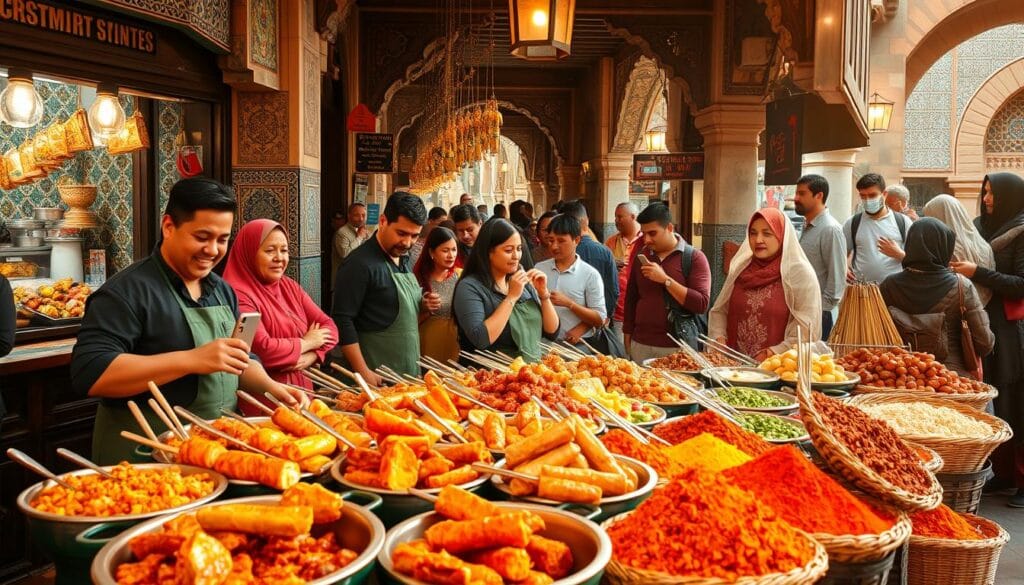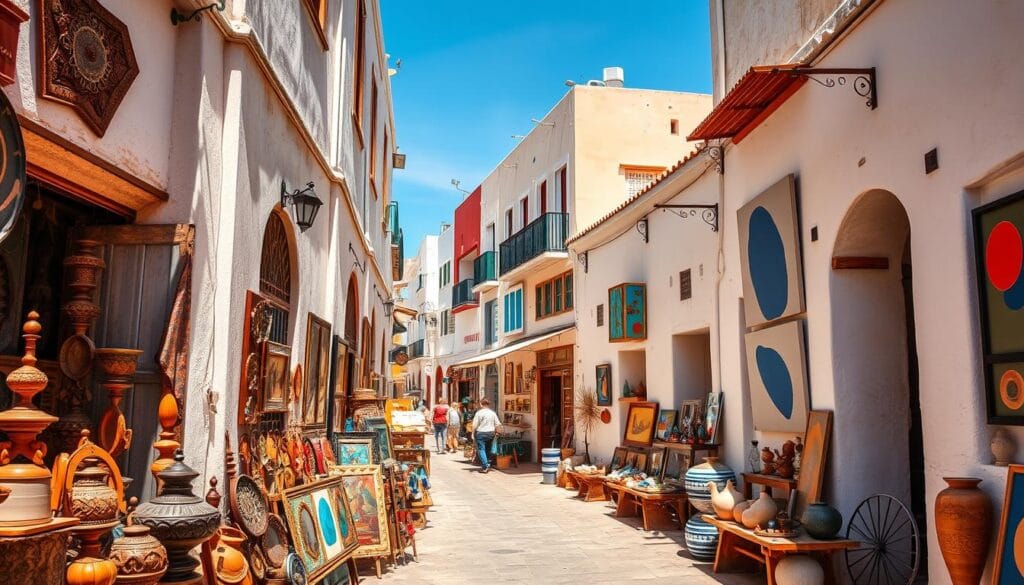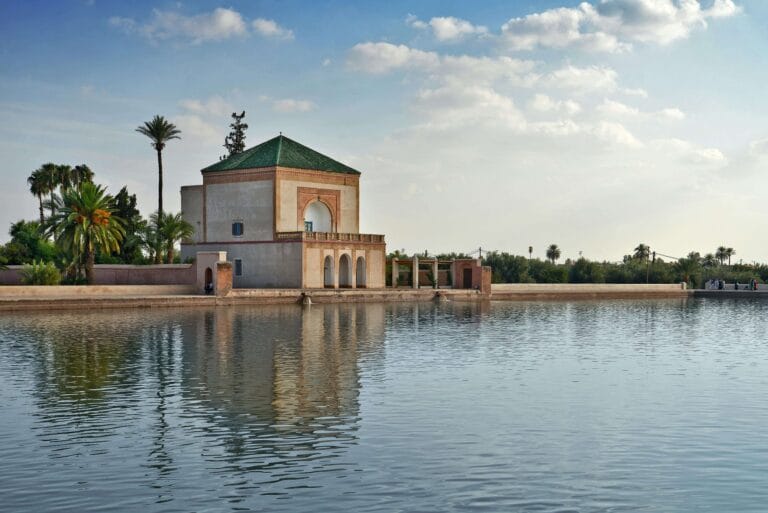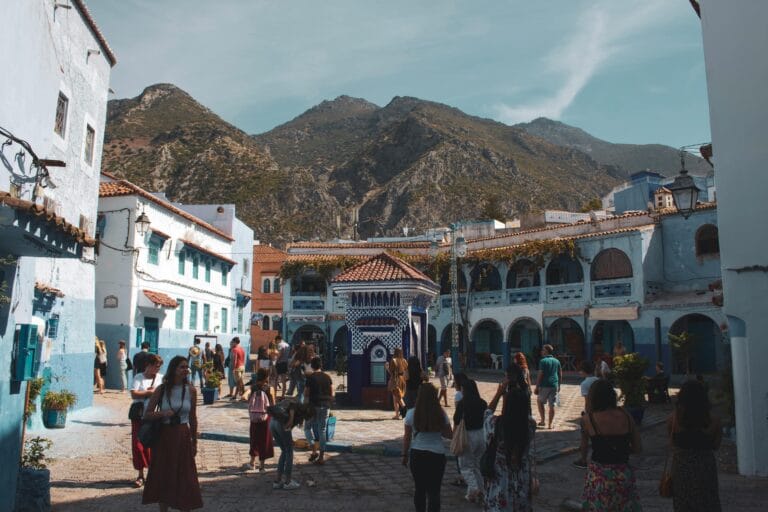
Did you know over 60% of travelers to Morocco never venture beyond Marrakech or Casablanca? Those who do discover a coastal gem where history whispers through blue-and-white alleyways and salty breezes carry the rhythm of daily life. This is Essaouira—a place where relaxation meets authenticity.
The cool coastal air here feels like a secret handshake among locals. Unlike busier cities, this UNESCO-listed destination thrives on its laid-back charm. Artists, surfers, and storytellers blend seamlessly in its sunlit squares, creating a vibe that’s equal parts tradition and creativity.
Jimi Hendrix’s 1969 visit cemented the city’s bohemian reputation. Though myths about his stay swirl like Saharan sand, his spirit lingers in murals and music drifting from harbor-side cafes. Today, the lively medina and expansive beaches remain its heartbeat.
Ready to trade tourist checklists for sunrise strolls along fortified walls? This guide unlocks hidden courtyards, surf spots where fishermen trade tales, and markets bursting with argan oil treasures. Let’s dive into the rhythms of local life—one mint tea sip at a time.
Table of Contents
Discover the Vibrant Medina
Step into a living tapestry where cobalt-blue doors frame streets humming with creativity. The medina’s UNESCO-protected grid—designed by European architects in the 1700s—blends North African soul with geometric precision. Spend a day here, and you’ll quickly see why this place captivates artists and historians alike.
Explore Narrow Lanes and Artisan Shops
Follow your nose past cedarwood carvers and jewelers hammering silver under striped awnings. Locals joke that getting lost is part of the experience—every turn reveals handmade treasures like thuya wood boxes or vibrant textiles. Time slows as artisans share stories between crafting sessions, inviting you to watch centuries-old techniques unfold.
Witness the Blend of History and Modernity
Along the ramparts, Portuguese cannons still peer seaward while skateboarders grind across sun-warmed stones below. Open-air cafés buzz with mint tea drinkers swapping tales—“This spot? My grandfather proposed to my grandmother right here!” By late afternoon, the scent of freshly baked msemen flatbread guides you to family-run bakeries tucked behind mosaic arches.
As daylight fades, the medina transforms. Lanterns cast golden patterns on ochre walls, and music spills from hidden courtyards. Whether you’re sipping almond milk at sunrise or bartering for argan oil at dusk, this labyrinthine heart beats with stories waiting to be lived.
Stroll Along the Historic Ramparts
Wind-whipped stone walls tell tales older than the cannons that line them. Built in the 18th century by French engineers, these ramparts protected the strategic port from invaders while offering panoramic vistas. Today, their honey-colored stones form a 1.5-mile walkway where sea spray mingles with stories of pirates and poets.
Enjoy Breathtaking Atlantic Views
Follow the crisscrossing pathways to discover why filmmakers and photographers flock here. At sunset, the ocean transforms into liquid gold beneath the fortress walls. Local fishermen often pause here, mending nets while sharing tips about hidden coves. “Best free theater in Morocco,” one laughs, nodding toward breaching whales in the distance.
Relive Game of Thrones Filming Moments
Fantasy fans recognize these ramparts as Astapor’s slave city from Season 3. Stand where Daenerys Targaryen plotted her rise, and you’ll spot grooves from centuries-old cannon mounts underfoot. Nearby, a weathered stone archway leads to quiet streets where artisans sell driftwood sculptures. Chat with them about the HBO crew’s 2012 visit—many still recall the buzz.
Don’t rush this walk. Let the salt-kissed breeze guide you past blue fishing boats bobbing in the busy port. Along the way, stop at family-run juice stands offering pomegranate refreshers. Their secret? A pinch of local herbs handed down through generations. It’s these unscripted moments that turn a stroll into a memory.
Visit Sqala du Port
Where cannon fire once echoed, artists now sketch seaside vistas beneath honey-colored arches. Sqala du Port stands as a living monument to Morocco’s maritime past, its neoclassical curves whispering of European architects and Saharan trade winds. Built in the 1760s, this fortress guarded ships carrying spices, gold, and argan oil across stormy Atlantic waters.
Marvel at the Neoclassical Architecture
French symmetry meets Portuguese practicality in the Sqala’s design. Sunlight dances across fluted columns and arched gateways adorned with carved anchors—a nod to its naval roots. Look closely at the walls: weathered inscriptions reveal dates of repairs after pirate raids, while geometric patterns mirror those found in Marrakech’s palaces.
Local guides love pointing out the hidden symbols. “See these star shapes?” one might say. “They’re protection charms against evil spirits, added by 19th-century craftsmen.” Every stone tells two stories—one of European engineering, another of North African tradition.
Learn about Its Trade and Fortification History
For centuries, these ramparts shielded treasures bound for Marseille and Lisbon. Merchants haggled over cedarwood and salt in vaulted chambers now filled with the chatter of café patrons. The streets nearby still bear grooves from oxcarts hauling goods to waiting ships.
Today, fishermen mend nets where soldiers once paced. “My great-grandfather traded sardines here,” shares a vendor selling mint tea by the old watchtower. As seabirds circle overhead, you’ll feel the pulse of history in every salt-crusted brick—a blend of past grit and present-day charm.
Experience the Bustling Fishing Port
Before sunrise, the harbor hums like a well-tuned orchestra. Fishermen haul silvery sardines and ruby-red tuna onto weathered docks while seagulls swoop for scraps. This is where the city’s culinary heartbeat thrums—a place where tradition meets the tides.
Immerse in Early Morning Fish Markets
Arrive by 6 AM to catch the action. Crates overflow with today’s catch as buyers haggle in rapid-fire Moroccan Arabic. The air tastes salty, mingling with smoke from grills already charring fresh octopus. “Best prices go to early birds!” shouts a vendor, his hands glistening with fish scales.
Nearby shops sell lemon wedges and crusty bread—perfect companions for beachside picnics. Watch couples wander hand-in-hand, drawn by the rhythm of crashing waves and sizzling skillets.
Savor Fresh Local Seafood
Follow your nose to family-run shacks lining the port. Menus change hourly based on the morning’s haul. Try grilled sardines drizzled with argan oil or buttery shrimp skewers served on recycled fishing nets. Locals swear by the octopus tagine simmered with olives and preserved lemons.
| Must-Try Dish | Key Ingredient | Best Spot |
|---|---|---|
| Fish Chermoula | Cumin & Paprika | Aziza’s Grill |
| Seafood Paella | Saffron & Mussels | Harbor Bites |
| Crab Bisque | Local Cream | La Marée |
As waves crash against ancient stone walls, you’ll understand why this port fuels both bellies and stories. It’s more than a meal—it’s a front-row seat to Morocco’s coastal soul.
Experience Genuine Essaouira Local Culture
Cultural immersion here begins with a smile and a story. As a world heritage site, the city’s soul lives in its people—fishermen mending nets, grandmothers kneading dough, and children chasing soccer balls across sunlit plazas. At Place Moulay Hassan, the main square, life unfolds like an open book. Locals gather under striped umbrellas, swapping news as seagulls circle above.
Interact with Warm and Laid-back Locals
Strike up a conversation at a spice stall, and you might leave with a free tea sample—and an invitation to a family dinner. “Visitors today become friends tomorrow,” laughs Amina, a rug weaver near the old port. Her hands move swiftly, weaving patterns passed down through generations while she shares tales of the medina’s hidden courtyards.
The world heritage site status isn’t just about architecture—it’s preserved a way of life. Watch carpenters carve thuya wood near Place Moulay Hassan, their workshops fragrant with cedar oil. Many learned their craft from grandparents, keeping traditions alive one intricate box at a time.
Even café owners become guides here. At sunset, join regulars sipping mint tea on rooftop terraces. “This square?” says a shopkeeper, pointing to the bustling heart of the world heritage site. “My great-uncle played here as a boy. Same laughter, same sea breeze.” These moments—raw and unscripted—reveal why this coastal gem feels like nowhere else on earth.
Relish Moroccan Cuisine and Street Food Delights

Food here isn’t just a meal—it’s a story told through flavors and aromas. The medina’s UNESCO World Heritage status isn’t just about architecture; it’s a backdrop for sizzling skillets and family recipes passed through generations. From dawn till dusk, the air hums with cumin, saffron, and laughter.
Discover Crepe Stalls and Seafood Shacks
Follow the scent of freshly baked msemen to hole-in-the-wall stalls near Place Moulay Hassan. Vendors flip paper-thin crepes filled with almond paste or honey, their griddles etched with castles made sand motifs—a nod to ancient Berber designs. Locals line up for crispy sardine sandwiches wrapped in newspaper, a quick breakfast before work.
By the port, seafood shacks serve today’s catch on recycled fishing nets. “My grandfather sold sardines here when Moulay Hassan ruled,” shares a cook grilling octopus near a castles made sand-themed eatery. Try the spicy shrimp tagine simmered in clay pots, or grab a cone of fried calamari dusted with paprika.
Modern twists thrive too. At Café Moulay Hassan, chefs stuff flaky pastries with argan-infused goat cheese. Don’t miss the fig-glazed lamb served on cedarwood platters—a dish that mirrors the city’s layered history. Every bite? A delicious chapter in Essaouira’s UNESCO World Heritage tale.
Get Active with Kite-Surfing and Outdoor Adventures
Feel the Atlantic roar through your hair as you harness Essaouira’s legendary winds. Nicknamed the “Windy City of Africa,” this coastal gem transforms into an adrenaline playground when trade winds whip across its shores. Here, history meets high-energy fun just steps from the medina essaouira.
Ride the Waves and Feel the Wind
Local surf schools near essaouira beach buzz with energy year-round. Glide across waves where wind speeds average 20 knots—perfect for beginners and pros alike. “First-timers catch air here faster than anywhere else,” grins a instructor tightening a harness. Watch fishing boats bob in the distance as you carve through turquoise swells.
Explore Quad Biking and Horse Riding
Prefer land-based thrills? Rev through argan tree forests on quad bikes, kicking up dust along coastal dunes. Guides lead sunset rides where wild beaches stretch for miles. For slower-paced magic, trot Arabian horses past crumbling forts and salt marshes. Many trails start just beyond the medina essaouira walls.
These adventures blend seamlessly with cultural exploration. After riding waves or dunes, stroll back to the essaouira beach promenade within minutes. Grab grilled sardines from vendors near weathered fishing boats, your afternoon soundtrack blending crashing waves and medina laughter.
Join a Traditional Moroccan Cooking Class
Moroccan cuisine dances on a tightrope of flavors—where sweet meets spice and history simmers in every pot. Local cooking classes offer more than recipes; they’re living heritage experiences connecting you to centuries of trade routes and family traditions. Your journey begins where locals shop—bustling markets bursting with colors and stories.
Shop at Local Markets for Fresh Ingredients
Dawn light filters through woven baskets of saffron and cumin at the souk. Guides teach you to spot plump Medjool dates and fragrant ras el hanout blends. “This turmeric? From our mountains,” beams a vendor, wrapping spices in newspaper. You’ll gather olives preserved in lemon and argan oil pressed by Berber cooperatives—ingredients tied to the region’s world heritage status.
Learn Time-Honored Culinary Techniques
In airy riad kitchens, chefs reveal secrets passed through generations. Knead dough for msemen flatbreads using palm-heel presses perfected over centuries. Simmer tagines over charcoal, learning how Portuguese traders influenced spice blends. Many classes include walks through heritage sites like Place Moulay, where food and architecture share intertwined histories.
| Class Feature | Skills Learned | Location |
|---|---|---|
| Spice Market Tour | Tagines & Preserves | Near Place Moulay |
| Seafood Masterclass | Grilling & Chermoula | Port District |
| Pastry Workshop | B’stilla & Kaab el Ghazal | Medina Heart |
As you savor dishes under citrus trees, instructors share tales of Andalusian exiles and caravan routes. This edible education turns meals into memories—and keeps Morocco’s world heritage alive, one bite at a time.
Uncover Artistic Heritage and Contemporary Boutiques

What if every brushstroke whispered tales of Saharan caravans? This coastal gem thrives where ancient motifs meet bold modern designs. Wander past galleries housed in buildings reminiscent of castles made from sunbaked clay—their arched doorways framing vibrant canvases that reinterpret Berber symbols.
Visit Art Galleries and Charming Design Shops
At Galerie Damgaard, founded in 1969, abstract dunescapes echo patterns made sand famous by coastal winds. Nearby, Maison de l’Artisan sells hand-stitched leather journals embossed with astrolabe designs—a nod to Morocco’s navigational history. “We blend yesterday’s stories with today’s vision,” explains owner Fatima, smoothing a cobalt-blue textile.
The creative pulse extends to concept stores like Atelier Nomade. Here, jewelry mimics weathered fortress walls, while ceramics bear grooves inspired by tidal patterns. Don’t miss the pop-up exhibits near Place Moulay Hassan, where young painters reinterpret castles made legendary in local folklore through graffiti-style murals.
As a city Africa celebrates for its cultural fusion, this destination nurtures artists who bridge continents. July 1969 anecdotes linger in studios where Hendrix-era psychedelia meets Gnawa rhythms. Whether admiring mosaics crafted with made sand techniques or browsing minimalist lampshades shaped like fishing boats, you’ll discover why creativity here feels as endless as the Atlantic horizon.
Delve into the Jewish Quarter and Synagogue Sites
Behind the medina’s blue walls lies a neighborhood where centuries of coexistence shaped Morocco’s cultural DNA. The Jewish Quarter, known as Mellah, thrived from the 18th century as merchants and craftsmen settled near the port. Its narrow lanes still whisper stories of a time when nearly 40% of the city’s population was Jewish.
Explore Mellah History and Heritage
Founded in 1807, Mellah’s coral-pink buildings once housed vibrant markets and communal bakeries. “My grandfather sold spices here alongside Jewish neighbors,” recalls a shopkeeper near the old gates. The quarter’s design—with elevated walkways and shared courtyards—reflects a unique blend of Moroccan and Sephardic traditions.
Visit Chaim Pinto and Simon Attias Synagogues
The Pinto Synagogue, restored in 1999, stands as a testament to Rabbi Chaim Pinto’s legacy. Intricate stucco work and original Torah arks reveal craftsmanship rarely seen outside Jerusalem. Nearby, the Simon Attias Synagogue now hosts cultural exhibits, its cobalt-blue ceiling echoing the Atlantic horizon.
Local guides often share tales linking the area to July 1969—when global attention shifted to moon landings and rock legends. Some claim mystical energy from nearby Village Diabat influenced spiritual practices here. As you walk these streets, notice how Hebrew inscriptions blend with Arabic motifs on weathered doorframes.
Respectful visitors gain deeper insights into Morocco’s multicultural roots. Whether lighting a candle at Pinto’s tomb or chatting with artisans near Village Diabat, these encounters reveal layers of history often missed by hurried travelers.
Explore Hidden Corners Off the Tourist Trail
Beyond the cobalt doors and bustling souks lies a quieter side of the medina. While most UNESCO World Heritage sites draw crowds, this labyrinth rewards those who wander beyond guidebook highlights. Here, time bends around sun-dappled courtyards and doorways framed by fading frescoes.
Find Secluded Spots in the Medina
Turn down Rue Laalouj, where the hum of the main square fades. You’ll find grandmothers weaving palm fronds into baskets under fig trees. These alleys remain untouched by “tour groups that stick to the main arteries,” as a local spice seller explains. Look for tucked-away gems like Dar Souiri—a 19th-century home turned art space with original zellige tilework.
Near Place du Marché aux Grains, a hidden passage leads to a courtyard where carpenters carve thuya wood. The scent of cedar oil lingers as craftsmen demonstrate techniques unchanged since the medina’s founding. “This is where we come to breathe,” shares a potter shaping clay near a centuries-old well.
| Popular Spot | Hidden Alternative | Local Tip |
|---|---|---|
| Skala du Port | Ramparts’ South Tower | Sunrise views, zero crowds |
| Main Souk | Berber Pharmacy Alley | Herbal remedies & stories |
| Fish Market | Hammam Sidna | Traditional bathhouse rituals |
Self-guided explorers thrive here. Follow mosaic clues in the pavement to discover a family-run argan oil co-op or a rooftop café serving mint tea with wildflower honey. These pockets of calm reveal the medina’s soul—one whispered secret at a time.
Unwind on the Sandy Beaches
Imagine warm sand slipping between your toes as the Atlantic breeze carries laughter from passing camels. Essaouira’s beaches stretch like golden ribbons, offering visitors a front-row seat to nature’s daily spectacle. Here, relaxation isn’t planned—it unfolds with each crashing wave and seagull’s cry.
Stroll Along Essaouira Beach
Walk barefoot where the ocean meets powder-soft dunes. Fishing boats painted in cobalt blue bob near the shore, their nets drying in the sun. “Best time? An hour before sunset,” shares a local shell collector. Watch horseback riders gallop along the water’s edge as tides erase their hoofprints.
Relax in Cozy Beachside Cafes
Beach shacks here serve more than views. Order grilled sardines drizzled with lemon and argan oil at Café du Port—their secret recipe dates back three generations. Sip mint tea under striped umbrellas while artists sketch the horizon. “Our seafood tastes better with sand between your toes,” jokes a waiter balancing trays of steaming tagines.
Visitors often linger until stars appear, lulled by the rhythm of crashing waves. Whether building sandcastles with local kids or sharing stories with fishermen, these shores blend tranquility with authentic charm. Make time to wander—the beach rewards those who move at nature’s pace.
Embrace the Bohemian Vibe and Local Legends
Where Atlantic winds meet Saharan whispers, a creative pulse thrums through sun-bleached alleyways. This town wears its countercultural heart on its sleeve—a place where art spills onto streets and myths cling to every mosaic.
Discover the Legacy of Jimi Hendrix
Though Jimi Hendrix spent mere days here in 1969, his spirit lingers like sea mist. Locals still debate which riad hosted the guitarist, but murals near the port immortalize his visit. “He came for the music, stayed for the soul,” says a shop owner displaying vintage vinyl records.
Decades later, shops like Gnawa House fuse Hendrix-era psychedelia with Berber rhythms. Hand-painted teapots and indigo-dyed textiles line their shelves, drawing artists seeking inspiration. Over the years, these spaces have become galleries for storytellers and poets.
The town’s free-spirited identity shines in tucked-away studios. At L’Atelier Nomade, jewelers craft silver pendants shaped like waves—a nod to the ocean’s eternal muse. Don’t miss Café Tissardmine, where mismatched chairs and beat-up guitars invite impromptu jam sessions.
To truly grasp this creative melting pot, chat with elders sipping tea near Place Moulay Hassan. Their tales of hippie caravans and years of cultural exchange reveal why this coastal haven remains Morocco’s beating bohemian heart.
Conclusion
As your journey through this coastal gem comes to a end, its layers reveal themselves—ancient ramparts framing surfers at sunset, spice-scented alleyways leading to galleries. Essaouira thrives where heritage meets curiosity, inviting travelers to write their own stories in sun-bleached streets.
From medina artisans preserving centuries-old crafts to adrenaline-pumping kiteboarding sessions, every moment bridges past and present. Linger over grilled sardines at portside restaurants, where fishermen’s catches become tomorrow’s legends. These flavors and rhythms stick like salt in the air.
Let this guide fuel your adventure through Morocco’s creative soul. Return seasons later, and you’ll still find new corners whispering secrets. True discovery here honors the city’s heritage while chasing fresh horizons. After all, every end in this windswept paradise sparks the start of your next chapter.






